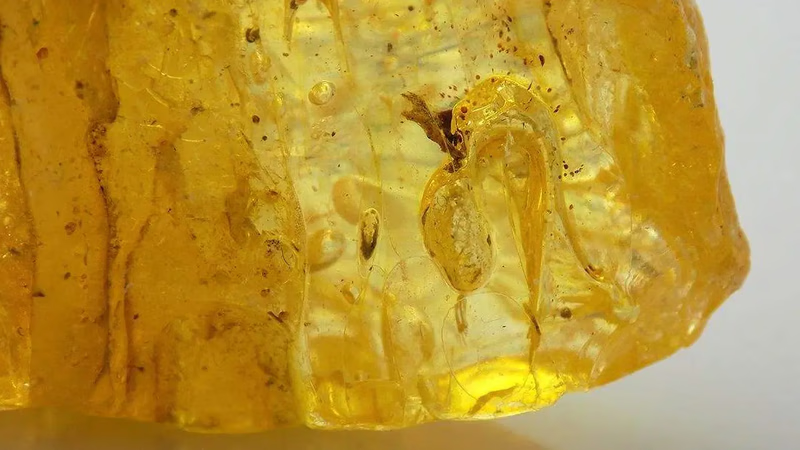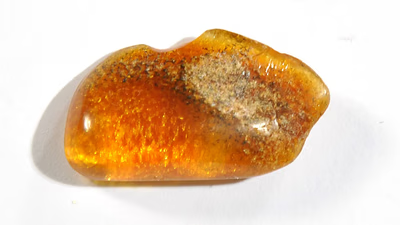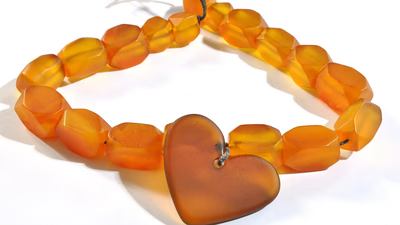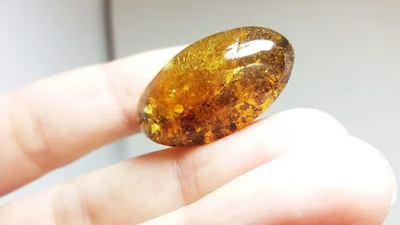
Asian Amber gemstone offers calming effects and emotional support.
The original Asian Amber gemstone, also known as Baltic Amber, is believed by some to have various advantages on the body and mind. It's important to note that these claims are based on traditional beliefs and alternative healing practices, and they may not have scientific evidence to support them. Amber gemstone is believed to have a soothing and calming effect on the body and mind. It is often used in alternative medicine practices to promote relaxation, reduce stress, and ease anxiety. Some people wear Amber jewelry or use Amber-infused products with the intention of experiencing these calming effects.
Amber is considered a protective gemstone in many cultures. It is believed to ward off negative energies, promote healing, and provide a sense of grounding and stability. Some people wear Amber jewelry or keep Amber stones in their living spaces for these protective and healing purposes. Amber is associated with emotional support and is believed to help alleviate feelings of depression, sadness, or emotional instability. It is thought to bring warmth and positivity to one's emotional state and promote a more optimistic outlook.
- Absorption of negative energies in the environment and its conversion into positive energies
- Increasing vitality and help regenerate body cells
- Reducing pain and improve people's mental and emotional well-being
- Enlightening the mind and thus cause awareness of the soul and body
- Having the power of calming emotions
- Raising the will in the person
Baltic Amber contains succinic acid, which is believed to have anti-inflammatory properties. Some people believe that wearing Amber jewelry can help reduce inflammation and promote a healthy immune response. This stone makes us want to cure diseases and maintain balance in the body. Amber increases willpower and supports us in early treatment so that we do not take it lightly. Amber or "soothing stone" is a type of crystal that calms a person's nerves. It removes negative energies from the person and encourages him not to make life too hard. This stone can also soothe emotions during post-surgery care. The healing effects of amber include:
- Controlling excess energy and removing negative energy
- Gain positive energies and create peace
- Therapeutic properties:
- Treatment of osteoarthritis
- Treatment of arthritis
- Asthma treatment
- Pest treatment
- Allergy treatment
- Treatment of eczema
- Treatment of bronchitis
- Treatment of swollen feet
- Treatment of spinal disorders
- Treatment of herpes
- Repel bad eyes
- Treat itchy skin
- Treatment of facial pain
- Treatment of pimples and boils
- Stimulation of growth
- Wound healing
- Treatment of shingles
- Treatment of spinal deviation
- Cough treatment
- Among the forehead and support stones
- Treatment of sciatica
- CIA treatment of cough
- Treatment of atherosclerosis
- Treatment of dandruff
- Treatment of bile
- Treatment of infection
- Strengthen muscles
- Strengthen ligaments
It's important to remember that the perceived advantages of Asian Amber gemstone are based on alternative healing practices and individual beliefs. While many people find value in these practices, it's always advisable to consult with healthcare professionals for any specific health concerns or conditions. Additionally, scientific research may not necessarily support these claims, and individual experiences can vary.
Since amber is not technically a mineral, but has long been used for its energy and healing properties. Amber is an energetic purifier and stone and acts on energy levels, emotionally and physically to convert negative or stagnant energies into clear and usable frequencies. This stone can help the person in clearing the halo as well as the vibrations that has in his surroundings. This makes amber a great stone for protection because it turns the negative into a source of clear energy.
-

West Asian Amber features a diverse color spectrum, with honey-colored and cognac-colored amber being among the most sought after. Honey-colored amber displays warm golden shades, while cognac-colored amber ranges from light to deep reddish-brown hues. Cherry-colored amber, characterized by its reddish tones, adds to the variety. The primary source of amber is the coniferous plant Pinus succinifera, although other conifers produce lesser amounts. Over 250 color spectrums and seven main colors of amber have been identified, including yellow, orange, white, green, and blue. Yellow amber constitutes about 70% of global production and is primarily sourced from the Baltic Sea region. Green amber, which makes up about 2% of the spectrum, is created by heating yellow amber and is often paired with silver in jewelry making. Red amber is rare, found in only one out of every 200 samples, historically favored by the wealthy due to its scarcity.
Blue amber is the rarest type and changes color under fluorescent light. Other notable colors include butterscotch and olive-colored ambers. Each type has unique characteristics that influence its market value and appeal in jewelry design.
-

The Asian market plays a crucial role in the global amber gemstone trade, with countries like China, India, Thailand, and Hong Kong leading in both domestic and international sales. The growing consumer base in Asia has heightened the demand for amber due to its cultural significance and perceived healing properties. Buyers and sellers are encouraged to research prices and work with reputable sellers to ensure fair transactions. Online platforms have gained popularity, offering convenience and access to a diverse range of amber gemstones. These platforms often feature special deals that can lead to attractive pricing. Understanding local regulations regarding import/export and ensuring gemstone authenticity is vital for smooth transactions. Direct purchasing from production units is a cost-effective method for buyers, allowing them to acquire high-quality amber at reasonable prices. The proximity to production sources and skilled artisans contributes to competitive pricing in the Asian market. Additionally, various trade shows and exhibitions provide opportunities for networking among buyers and sellers, showcasing a wide array of gemstones including amber.
-

Amber has been valued since ancient times, with archaeological evidence tracing its use back to the Stone Age. It was traded extensively, particularly Baltic Amber, which became a significant commodity during the Roman Empire. This gemstone held cultural importance across various civilizations, often used in religious ceremonies and as decorative items believed to possess protective and healing properties. The Baltic region, especially Lithuania, Latvia, and Estonia, is renowned for its high-quality amber known for its rich colors and clarity. Each locality offers unique characteristics that enhance its desirability. Today, amber continues to be cherished in jewelry and scientific research. While often mistaken for a gemstone, amber is actually fossilized tree resin. The oldest known amber dates back approximately 320 million years.
In Asian cultures, it symbolizes courage and protection during journeys. The Greeks and Romans recognized its origins, with Aristotle referring to it as "succinum. " Modern sources of amber include the Dominican Republic, known for rare blue variations; Mexico"s Chiapas region; and historical sites in Poland, Russia, Ukraine, and Belarus. Amber"s global presence extends to Myanmar, Canada, the U. S. , Lebanon, and parts of Africa.
-

The original Asian Amber gemstone, often referred to as Baltic Amber, is associated with various benefits for the body and mind, primarily rooted in traditional beliefs and alternative healing practices. Advocates claim that Amber has a calming effect, promoting relaxation and reducing stress and anxiety. It is also thought to absorb negative energies and convert them into positive ones, enhancing emotional stability and vitality. Many users wear Amber jewelry or utilize Amber-infused products to experience these purported effects. The gemstone is believed to possess anti-inflammatory properties due to its succinic acid content, which may aid in reducing pain and supporting immune health. Additionally, Amber is linked to emotional support, helping alleviate feelings of depression and fostering a more optimistic outlook. Its therapeutic applications are extensive, including treatments for conditions such as arthritis, asthma, eczema, and more. While many individuals find value in these claims, it is essential to approach them with caution as scientific evidence may not fully support these assertions.
Consulting healthcare professionals for specific health concerns remains advisable. Overall, the perceived advantages of Asian Amber highlight its role as an energetic purifier that can transform negative energies into positive frequencies.
-

Amber gemstones are valued based on their design, quality, and origin. Unique patterns, inclusions, and vibrant colors significantly enhance their worth. The craftsmanship involved in shaping and polishing the gemstone also plays a crucial role in pricing. Regions like the Baltic are renowned for high-quality Amber, which can command higher prices due to their reputation. Factors such as the type of stone, design quality, and quantity ordered influence pricing. Additionally, Amber"s ability to preserve ancient inclusions adds to its desirability among collectors. Treatments like heat enhancement can affect value; untreated stones are generally more sought after. Market dynamics, including supply and demand fluctuations, also impact pricing trends.
Buyers should seek reputable sellers for original Amber gemstones with exceptional designs at reasonable prices. "





